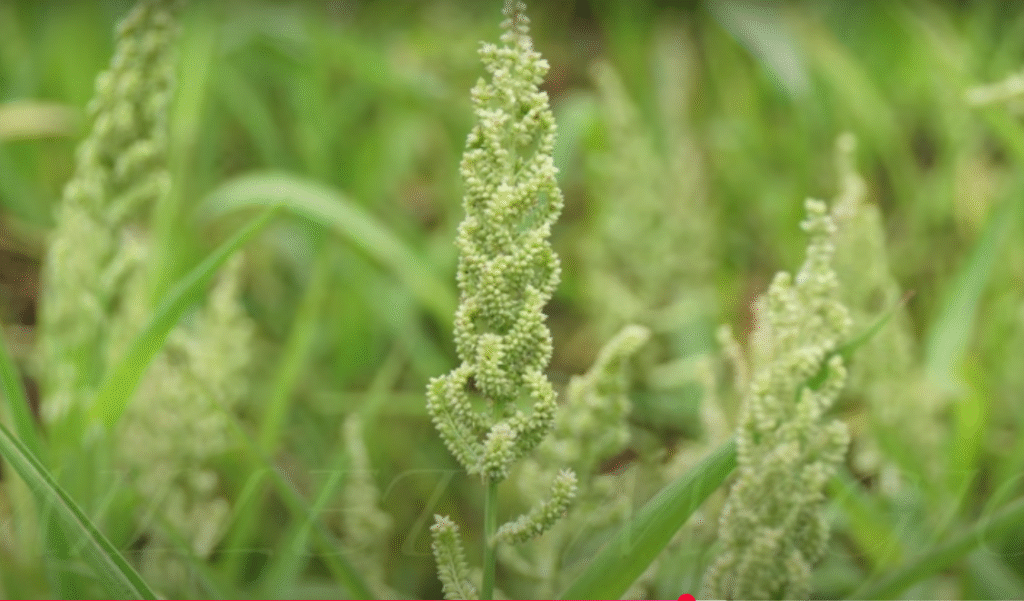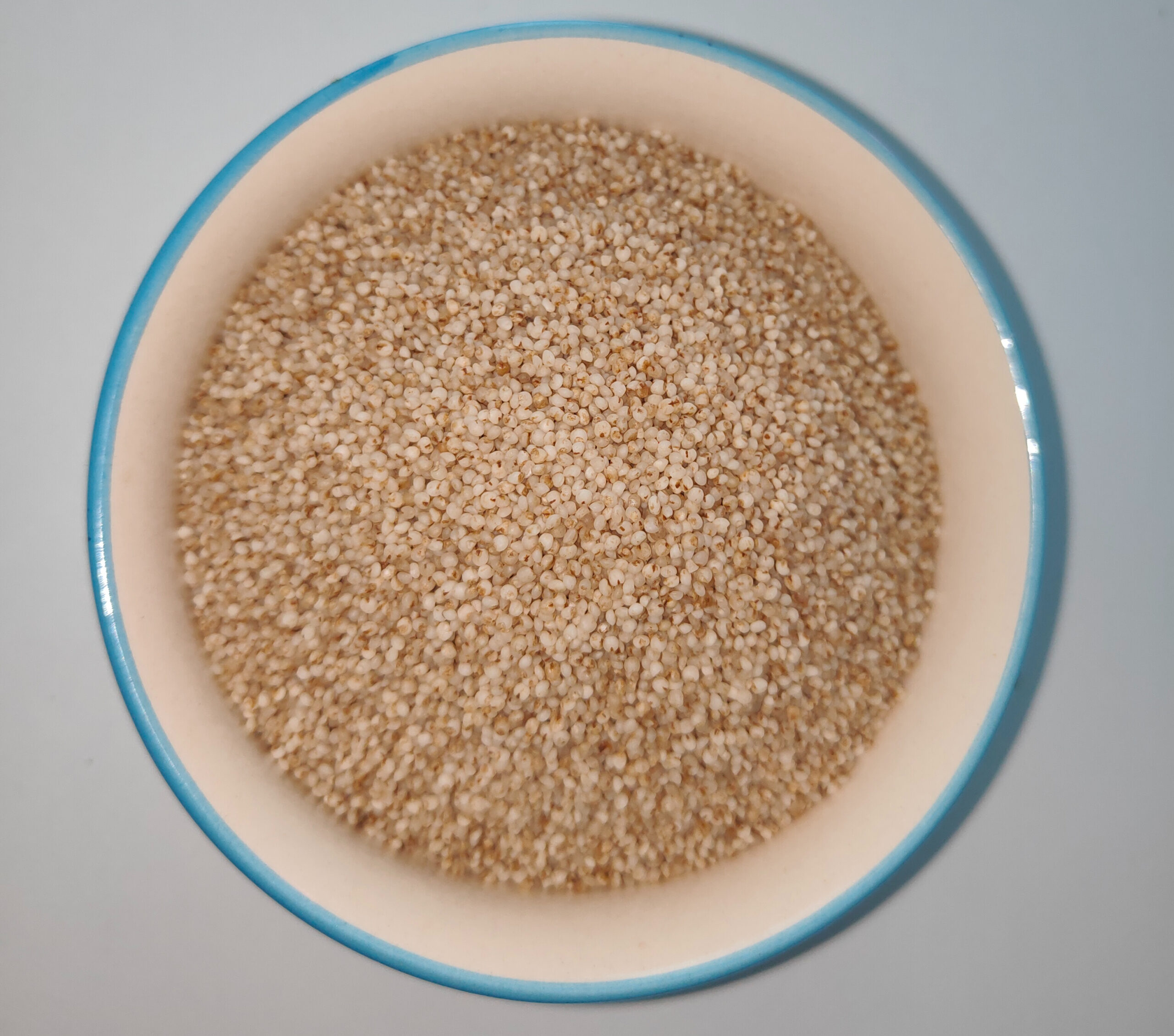This foundational guide on Barnyard Millet offers more than just facts — it carries the wisdom and research of the renowned “Millet Man of India”, whose dedication has brought ancient grains back into the spotlight. Before diving into the incredible health benefits of Barnyard Millet, take a moment to explore our blog post: What is Millet?
Table of Contents
Why the Name Barnyard?
Barnyard millet is a small flat cream colored grain. It has very beautiful panicle of grass which attracts thousands of birds.

The name “Barnyard millet” comes from its association with barnyards, where it often grew wild or semi-wild near human settlements and animal enclosures. Over time, this naturally growing grass was recognized for its resilience and quick growth, and some varieties were domesticated into what we now know as Echinochloa frumentacea—the cultivated barnyard millet.
So, the name “barnyard” doesn’t come from its origin in agriculture, but from the wild environments—often untended and rustic—where its ancestors flourished. The name stuck, even after it became a formally cultivated crop.
Curious to know how this remarkable grain is named across different cultures and languages? Let’s take a look —

Health Benefits
Barnyard millet is a positive grain. As shared by the revered “Millet Man of India,” this title isn’t just a label, but a reflection of its powerful impact on our well-being. With a rich fiber content of 10% and a carbs-to-fiber ratio of less than 10, Barnyard millet stands out as a truly nourishing whole grain. It has the natural ability to cleanse, heal, and rejuvenate the body, offering real hope in reversing lifestyle-related diseases. Barnyard millet may be small in size, but it’s a powerhouse of nutrition. This ancient grain, once a staple in traditional diets, is now gaining attention as a modern superfood. Here’s why adding barnyard millet to your meals can be a game-changer for your health:
🧍 1. Liver & Soft Organs
Barnyard millet cleans the soft parts of human body like the liver, pancreas, gall bladder, spleen, kidney. Any problems with liver like jaundice, viral infections like hepatitis, or even gall bladder stones or spleen or pancreases diseases, eating barnyard millet Ambali (fermented porridge) will help according to Dr. Khadar Valli (see details in Video section).
🌾 2. Rich in Fiber – Supports Digestion and Weight Loss
Barnyard millet contains nearly six times more fiber than white rice, making it excellent for digestion. It helps regulate bowel movements, prevents constipation, and keeps you feeling full longer—supporting healthy weight management.
💓 3. Low Glycemic Index – Great for Diabetics
This millet has a low glycemic index (GI), which means it releases sugar slowly into the bloodstream. This prevents sudden spikes in blood sugar levels, making it an ideal grain for diabetics and those managing insulin resistance.To read in detail how millet can help reverse diabetes check the blog post here.
🩸 4. High Iron Content – Fights Anemia
Barnyard millet is rich in iron, significantly more than rice or wheat. Regular consumption can help improve hemoglobin levels and prevent anemia, especially important for women and children.
💪 5. Gluten-Free – Safe for Celiac and Gluten Sensitivity
Being naturally gluten-free, barnyard millet is a safe and healthy choice for people with celiac disease or gluten intolerance. It’s a wholesome alternative to wheat-based products.
🦴 6. Good Source of Calcium and Phosphorus – Supports Bone Health
This millet provides calcium and phosphorus, which are essential for strong bones and teeth. It’s particularly beneficial for growing children, pregnant women, and older adults at risk of osteoporosis.
❤️ 7. High in Antioxidants – Boosts Immunity
Barnyard millet is loaded with phenolic compounds and antioxidants that help fight oxidative stress in the body, supporting the immune system and reducing the risk of chronic diseases.
🏃 8. Quick Energy – Ideal for Active Lifestyles
Because it digests slowly but steadily, barnyard millet provides long-lasting energy. It’s a perfect grain for athletes, children, and anyone needing sustained stamina throughout the day.
🧘 9. Alkaline and Easy to Digest – Gentle on the Stomach
Unlike acidic grains, barnyard millet is alkaline, making it soothing and balancing for the stomach. It’s a great choice for people recovering from illness or managing acidity and digestive disorders.
🏋 10. Rich in Nutrients
Barnyard millet is rich in fiber and all essential nutrients for the human body. It is a powerhouse of nutrition. For nutritional value check Nutrition.
In Summary:
Barnyard millet is more than a traditional grain—it’s a nutritional gem that supports soft organs like liver, pancreas, gall bladder, kidney, spleen, heart health, boosts energy, controls blood sugar, and strengthens bones, all while being gentle on the gut.
A bowl of barnyard millet is not just food—it’s nourishment, healing, and heritage in every bite.
Nutrition
Barnyard millet is a highly nutritious, gluten-free grain that is commonly consumed in many parts of Asia and Africa. It’s especially valued for its low glycemic index and rich nutrient profile. Here you find Nutrients and Fiber content in 100gm of Barnyard Millet in comparison with other positive millet.
Comparison with Rice & Wheat
Here’s a more comprehensive chart comparing Banryard millet, paddy rice, and wheat based on average values per 100 grams:
Source: Dr.Khadar Vali


Watch video in Hindi for detailed explanation.
Key Takeaways:
- Barnyard millet is significantly richer in fiber, magnesium, phosphorus, potassium, and zinc than white rice and refined wheat.
- It has a lower glycemic index, making it a better option for blood sugar management.
- Refined wheat flour & rice, is nutritionally depleted during processing and lacks the mineral diversity and fiber content of millet.
Health Benefits Comparison with Rice & Wheat
| Health Aspect | Barnyard Millet | White Rice | Whole Wheat |
|---|---|---|---|
| Gluten-free | ✅ Yes | ✅ Yes | ❌ No |
| Supports digestion | ✅ High fiber | ❌ Very low fiber | ✅ High in fiber |
| Blood sugar control | ✅ Low GI, slow carb absorption | ❌ High GI; quick sugar spikes | ⚠️ Moderate GI |
| Weight management | ✅ Keeps you full longer | ❌ Less filling | ✅ Good satiety |
| Heart health | ✅ Rich in antioxidants & magnesium | ❌ Poor in heart-protective nutrients | ✅ Supports heart health |
| Bone strength | ✅ Good calcium & magnesium | ❌ Low in bone-support nutrients | ✅ Moderate calcium & magnesium |
| Rich in B Vitamins | ✅ Supports energy, nerves, and brain health | ❌ Very low in B vitamins | ✅ Especially rich in niacin & thiamine |
| Antioxidant content | ✅ High | ❌ Very low | ⚠️ Moderate |
| Iron content | ✅ High | ❌ Low | ✅ Good amount |
🧠 Why B Vitamins Matter
- Thiamine (B1): Supports nerve function, energy metabolism, and muscle health.
- Riboflavin (B2): Important for skin, eyes, and converting food into energy.
- Niacin (B3): Helps lower cholesterol, supports brain health, and aids in DNA repair.
Cooking Fermented Porridge (Ambali)
According to the Millet Man of India, eating fermented porridge (Ambali) of millet is most beneficial as it helps reverse lifestyle diseases.
Here is a simple guide on how to cook Barnyard millet into fermented porridge (also known as Ambali) for maximum health benefits:
✅ Ingredients:
1 cup Barnyard millet
6 cups or more water (adjust depending on millet type and texture preference)
Optional: A pinch of salt or spices
🥣 4 Easy Steps:
1. Rinse and Soak
- Rinse the millet 2–3 times to remove dirt and excess starch.
- Soak in water for 6–8 hours or overnight.
Soaking millet in water for 6-8 hours before cooking is essential for several health and cooking benefits. Here’s why:
Improves Nutrient Absorption
- Millets contain phytates (anti-nutrients) that bind to minerals like iron, zinc, and calcium, making them harder to absorb.
- Soaking helps reduce phytate levels, improving bioavailability of nutrients.
Aids Digestion
- Soaking helps break down complex starches and proteins, making millet easier to digest.
- It can also reduce bloating and gas, especially for people with sensitive stomachs.
Reduces Cooking Time
- Pre-soaked millet cooks faster and more evenly.
- This saves fuel or energy and ensures a better texture.
Lowers Glycemic Impact
- Soaking can slightly reduce the glycemic index by activating enzymes that pre-digest some of the starches, helping in better blood sugar control.
Enhances Flavor and Texture
- Soaked millet often has a softer texture and milder flavor, making it more palatable and versatile in recipes.
2. Cook Millet in Boiling Water
- Take an earthen clay cookware or steel pan
- Put 6 times water and boil the water
- Put soaked millet along with water used for soaking it
- Let it cook in medium flame/heat till half the water evaporates
- Slow the flame/heat & cover with lid till only little water is left
- Stop the gas/heat & leave it covered with lid for 30 mins till it slightly cools down
3. Ferment
- Cover the earthen ware with cloth, tighten the cloth
- Leave it still in one corner for 4-6 hrs (if its summer season) or 8-12 hrs (if its winter)
- Let it ferment
- Time required for fermentation is same as that of the curd
4. Add Salt/Spices/Vegetables
- After the fermentation is complete, you can add pinch of salt or spices(tadka) or sauted vegetables to make it tasty
🍽️ Tips:
- You can grind the millet before soaking if you want it more watery, this step is optional
- Do not heat it again after fermentation
- Do not add salt before fermentation, it can be added only after fermentation
- Curd or anything if desired to be added, should be added only post fermentation
If you have any doubts, watch the video on how to make millet fermented porridge here.
For more healthy Barnyard Millet recipes check here.
Who is the Millet Man of India?
The “Millet Man of India” is Dr. Khader Vali, a food and nutrition scientist renowned for promoting the cultivation and consumption of millets across India, especially traditional varieties like foxtail, little, kodo, barnyard, browntop, and proso millets.
Key Contributions of Dr. Khader Vali:
- Advocates millets as a solution to lifestyle diseases like diabetes, obesity, hypertension, and even certain cancers.
- Promoted the concept of “Siri Dhanya” (positive millets) to differentiate more nutritious millet varieties.
- Encouraged organic farming and natural healing through diet.
- Honored with the Padma Shri award in 2023 for his contribution to health and sustainable agriculture.
Videos
Watch this video in English to hear about Barnyard millet by Dr.Khadar Vali
Watch the video in hindi below.
Conclusion: Bring it Back to Your Plate!
So why, dear soul, do we not turn back,
To the grain that walks the ancient track?
Barnyard millet, with its earthy hue,
Is not just old—it’s wise, it’s true.It asks for little: no polished pride,
No chemical dance, no swollen stride.
It grows with rain, with sun, with time—
It waits, patient, in hills to climb.Let us not chase only what glitters white,
But look toward what nourishes right.
For in a bowl of barnyard millet, warm,
Is the pulse of the earth, steady and calm.Awaken the memory, revive the lore—
Let millet sing in homes once more.
For health, for heritage, for heart so still—
Let barnyard millet rise, and fill.

4 thoughts on “Barnyard Millet: 10 Health Benefits & Ambali Recipe to Heal You”